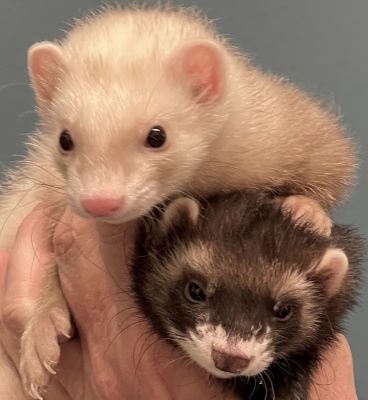
March is nearly over as time marches on. And that means our time with the ferret as our Animal of the Month is done – for now. But until we feature the ferret again as our Animal of the Month on Twitter @ExoticPetVets, we have a summary here of our tweets in care you missed any. Did you know?:
- Ferrets (Mustela putorius furo) are members of the weasel family, but the ferrets whom we are all familiar with as pets are not found in the wild.
- The ferrets who are commonly kept in captivity were domesticated from the European polecat more than 2,000 years ago.
- Because of selective breeding, domestic ferrets can be seen with a variety of different coat colours and markings. But the most common ferret kept in captivity is the sable ferret.
- Sable ferrets, who are also known as fitch ferrets, have beige bodies with black fur on their feet, front legs, necks, tails and facial markings.
- Some of the other domestic ferret breeds have names that sound delicious; including cinnamon, chocolate and champagne.
- Ferrets are fully grown at one-year of age. But there is a size differential between the sexes.
- Female ferrets weigh between .75–1.5 kgs (1.5–3 pounds) and are around 51 cms (18 inches) tip to tail. Males are larger than their female counterparts, weighing 1.5-2.5 kgs (3-5 lbs) and growing to 60 cms (24 inches) in length.
- Ferrets have cone-shaped heads that give way to long and slender bodies. They also have long tails, but short legs. They have long non-retractable claws which they use for digging, grasping and playing.
- Depending on where you live, the clocks jumped ahead for Daylight Saving Time this month and we lost an hour of sleep. So it’s a good month to live vicariously through ferrets because they are champion sleepers!
- Ferrets will sleep between 14 and 18 hours a day, every day! They are crepuscular, meaning they are most active at dawn and dusk.
- When they’re awake, ferrets are normally very active. They are intelligent and curious animals. They love interacting with their human family members and need mental stimulation and play every day.
- Their intelligence, curious nature and their slender bodies create the perfect combination that makes ferrets expert escape artists. If their head can fit into a space, that means they can fit their entire bodies into it too.
- This is the third time ferrets have been our Animal of the Month. But since we last featured them in July 2017, the world has changed significantly because of the COVID-19 pandemic. (The first time we featured ferrets as our Animal of the Month was in September 2014.)
- While humans seem to be the most vulnerable to COVID-19 and our knowledge of the virus continues to expand, ferrets have shown that they are also susceptible to contracting COVID-19.
- If you have ferrets in your family and/or have concerns about how ferrets may be affected by COVID-19, we recommend following the “Worms and Germs Blog” from the University of Guelph Centre for Public Health & Zoonoses.
- Even though black-footed ferrets (Mustela nigripes) are not domesticated, we want to give them a special mention because they recently made headlines.
- News broke last month that U.S. researchers successfully cloned a black-footed ferret who died in the mid-1980’s. The effort, which started in 2013, finally produced the clone who was born in Colorado in December 2020 and named Elizabeth Ann.
- Black-footed ferrets are the only wild ferret species endemic to North America and were once thought to be extinct until a small population was found in 1981 in Wyoming.
- The number of wild black-footed ferrets has rebounded since then thanks to breeding and re-introduction programs, but they are still listed as being endangered by the IUCN Red List.
- Elizabeth Ann, the cloned black-footed ferret, will be raised in captivity. She will eventually breed with other black-footed ferrets in the hope of saving this species.
- In another example of how humans will do anything for amusement, there is a “sport” called ferret-legging. It involves men putting a live ferret in their pants with the waist and legs sealed off. The winner is whoever can stand it the longest.
- There are conflicting reports on the origins of ferret-legging. It’s believed to have started in the U.K., but depending on the source, ferret-legging either started in the 1970’s or several centuries prior.
- There are also conflicting feelings about ferret-legging. Some say it is cruel and point out that it has a horrific history where people would mutilate the ferrets in order to ensure the least amount of harm done to the human.
- But others say the ferrets don’t mind as it is in their nature to enjoy being in enclosed spaces. The Manitoba Ferret Association even held a carefully-supervised ferret-legging fundraiser in 2007 to raise money to help homeless domesticated ferrets.
- Ferret-legging isn’t much of a “sport” these days and it seems to have given way to ferret racing, which is popular in the U.K. The spectacle involves ferrets racing through special pipes that include obstacles along the way.
- With proper care, ferrets living in captivity can live between 5 – 8 years on average.

